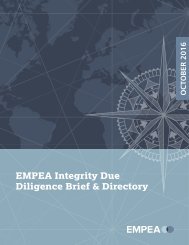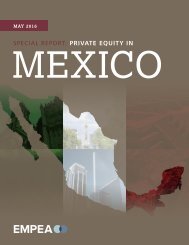MEXICO
1r3fkNK
1r3fkNK
Create successful ePaper yourself
Turn your PDF publications into a flip-book with our unique Google optimized e-Paper software.
EMPEA • MAY 2016 | 5<br />
For decades, Mexico remained under the radar as private equity<br />
investors with an interest in Latin America poured their money<br />
into Brazil. Headline risk around corruption and the war on<br />
drugs, a relatively small pool of fund managers, and the high<br />
concentration of large, family-owned businesses potentially<br />
restricting deal flow were among the many factors that had<br />
deterred greater investment. However, the tide appears to be<br />
turning—particularly with the entrance of the local pension funds<br />
(or Afores), which in 2009 were given the freedom to invest 10%<br />
of their assets into private equity under new regulations. Since<br />
this time, fund sizes for the more established general partners<br />
in the region have grown, while the total number of private<br />
equity and venture capital funds operating in the market has<br />
multiplied. In the eight years leading to 2016, Mexico-dedicated<br />
funds had raised nearly US$8.7 billion, with an additional portion<br />
of the US$12.7 billion raised by regional funds earmarked for<br />
the market (see Exhibit 1).<br />
Perhaps the most important driver, however, in pushing the<br />
asset class forward has been the Mexican government. It has<br />
demonstrated a deep appreciation for how private equity can<br />
help develop the economy, lead to job creation and instill best<br />
practices throughout local businesses, which puts the country<br />
well ahead of the curve in relation to a number of its emerging<br />
market peers. While the road is not always a straight one, the<br />
government, along with the local industry, has been focused on<br />
making continuous improvements to the legal and regulatory<br />
framework in favor of private equity, one small step at a time.<br />
A ROCKY ROAD<br />
The earliest private equity fund managers, the majority of which<br />
were large buyout firms based in the United States, began to flock<br />
to Latin America during the 1990s. On the back of their success<br />
with the asset class at home, many of these firms’ institutional investors<br />
were flush with cash and saw the fact that many emerging<br />
markets were increasingly opening up their economies as a means<br />
to generate high returns and diversify their portfolios. By the end of<br />
1999, over 100 private equity funds were deploying capital in Latin<br />
America. 1 Mexico—as well as a number of other countries across the<br />
region—saw substantial volumes of capital flow into the market.<br />
Unfortunately, a bust quickly followed the boom, and by the early<br />
2000s, many of these pioneers had not survived. In 2002, the former<br />
Texas-based buyout firm Hicks, Muse, Tate & First, Inc. and GE Private<br />
Equity, an investment arm of General Electric Co., both shut down<br />
their Mexico City offices, representing just two examples of firms on<br />
the retreat. The reasons were multifold: a growing realization that the<br />
model that had worked so well in a developed market context was<br />
not a plug-and-play that could be applied to Latin America, coupled<br />
with broader regional macroeconomic woes—including the aftermath<br />
of the 1994 Tequila Crisis—resulted in overall poor performance.<br />
“These early investors were not very happy because their results<br />
never materialized,” recalls Joaquín Ávila, Co-founder of EMX Capital.<br />
“What followed was a drying out of equity, and it took quite some<br />
time before people and money started to return to this industry.<br />
With the next wave, we started humble and small, but the opening<br />
of the local pension funds has really moved the needle.”<br />
Exhibit 1: Cumulative Private Capital Fundraising for Select Emerging Markets, 2008-2015 (US$B)<br />
$60<br />
$40<br />
4<br />
3<br />
9<br />
Other<br />
Colombia<br />
$100<br />
$80<br />
89<br />
US$ Billions<br />
$20<br />
13<br />
Peru<br />
Mexico<br />
Latin America regional<br />
26<br />
Brazil<br />
US$ Billions<br />
$60<br />
$40<br />
56<br />
29<br />
$0<br />
$20<br />
20 19<br />
$0<br />
China Latin America India CEE and CIS Sub-Saharan Africa<br />
Source: EMPEA. Data as of 31 December 2015.<br />
1. For more information on the history of private equity in emerging markets, see Roger Leeds, Private Equity Investing in Emerging Markets. New York: Palgrave Macmillan, 2015.





